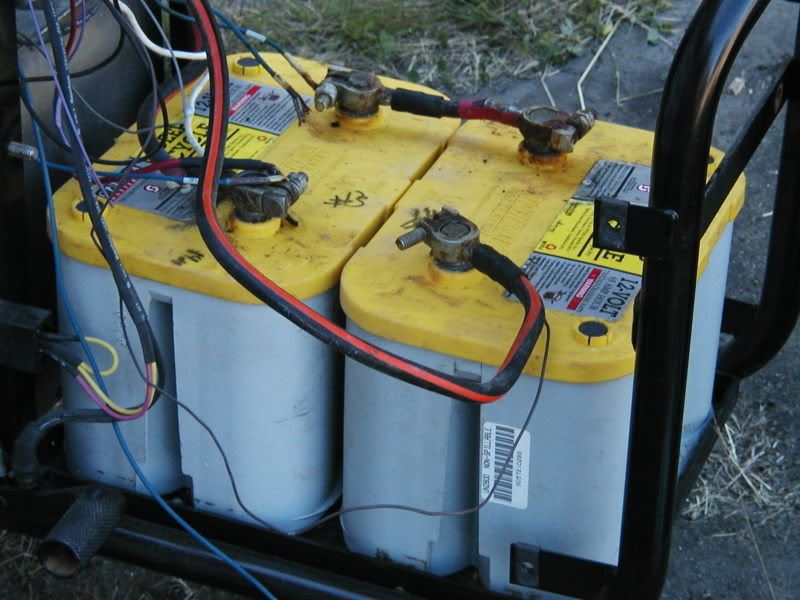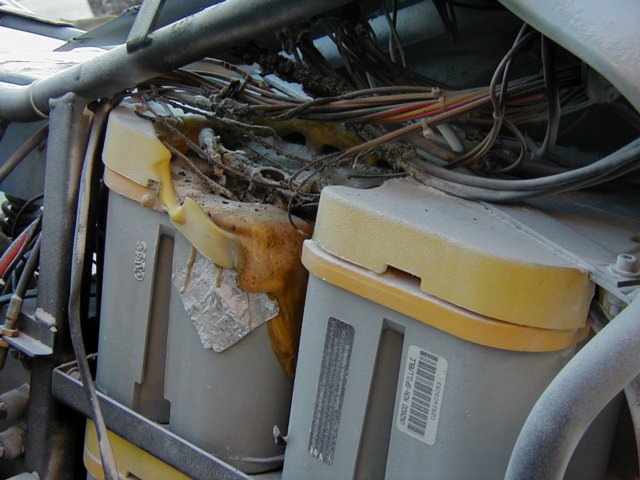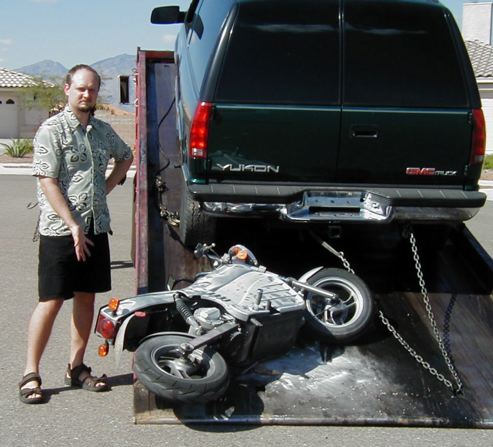Sadness, with a bit of Madness

Those that know me also probably have seen my EMB Lectra, one of the few production electric motorcycles in the world. That's it to the right, just after I unpacked the crate at the old headquarters of Electric Vehicles Northwest, where I actively participated in promoting the ownership and use of electrics. The battery pack died a few years ago, right around the time I got married, bought a fixer house, and started three new jobs. Needless to say, I didn't get around to replacing the pack.
Until recently. I promised beepbeep an update, so to the Boiling Frog I post.
Paul from the Electric Vehicle Discussion List was kind enough to donate four batteries he pulled from his electric dune buggy. Slightly used, to be sure, but free. The troubles installing them started almost right away.
Lectras are powered by four Optima Yellow Top (YT) Deep Cycle batteries. They are not typical, not by any stretch of the imagination. YTs deliver high energy, much higher than batts overcoming the resistance provided by typical water-based or "flooded" batteries. This high-discharge ability allows the Lectra to use a smaller pack and lower voltage. They also have no liquid electrolyte, using instead a paste that gives riders (like me) the ease of knowing that, should they dump the bike and have it wind up on top of them (as happened to me in '97 in a hit-and-run accident), the battery acid will not flow from the possibly ruptured batteries onto, well, me.
Sadly, since the Lectra was built in 1999 and today, Optima has changed its batteries, adding side terminal posts. These posts add less than a quarter of an inch to the width of the battery; however, since the battery mounts are designed to accomodate two batteries face-to-face, one must add insulation between these new posts. That adds just a bit too much width for one jumper cable to reach between the posts.

The pic above shows the bike with half of the old pack installed (two out of four batteries). The problem cable is the shorty linking the batts. With the new sideposts, that cable could be pulled just enough to get the back of the post, but could not be persuaded farther without wearing the post, damaging it.
One may ask: What's wrong with damaging the posts? What's a ding or two going to do?
One must, when considering this question, appreciate electricity in all her glory. Electricity likes to flow. Interruptions to that flow do not necessarily stop the flow; instead, they increase the resistance to the flow, which kinda slows the flow. . . and creates heat. Presented for your consideration, a picture of Derek Jones' Lectra Diary, just after Derek replaced his pack, but failed to adequately tighten the lugs.


Derek's story and pictures made an impact on me. Especially this one:

So I pursued a new battery cable, just slightly longer than the original. I finally got one. By the way, custom cables can be an adventure, if you're particular about safety!
And after installing all this battery stuff, I turn the key, hit the Neutral switch, and. . . nothing.
It turns out there is a wire dangling. It is intended to stick somewhere on the circuit board, evidently. I've checked all the available wiring diagrams I have, though, and can't find where. I have a suspicion, but would hate to stick it wrongly and have the tempermental electrons rebel. So, I've put out an email to the only expert on these bikes I know of, an owner/rider in England who seems to have a much firmer grasp of electricity and our bikes than I. I only hope the address is still good.
Grrrr. . . .
SOAPBOX MODE ON
Are electric vehicles a good idea, in general? I think so. I've been researching the subject now for almost 15 years. Electrics generally use power from the grid, which may or may not be produced in an ecologically responsible manner; but their efficiency is documentable, resulting in greater carbon efficiency even if the main source of power for recharging comes from the Worst of All Power Sources, coal. When one factors in other electrical sources, such as hydro and renewables, electrics promise quite a reduction in greenhouse gasses.
Did I know buying a cutting-edge mode of transport would be a big and expensive pain? Yes. I recognized at the time of purchase that lead-acid batteries were not the best tech for motive power, that they would wear out and need replacement, and that the cost of replacement would likely exceed the cost of fuel in a comparible vehicle.
I figured the first pack would be a learning experience. It was. I also figured by the time the pack needed replacement, a battery better for my bike would be available.
It hasn't. Not at any cost.
The war against electric rides is very real. You don't have to name the killer to know a murder has taken place; you only have to find a corpse.
I just finished watching Who Killed the Electric Car? Please, watch it. Though I knew of the backstory from following it on the internet and during my involvement with EVsNW, seeing the story in full just makes me angry. There are a lot of details not included in the movie of which I am familiar that, combined with the movie, debunk the official story of why no major automaker produces an electric-drive vehicle.
There were factories tooling up for car/bike batteries before the cars were killed; afterwards, these just closed, taking the promise of more appropriate power with them. Tax credits for electric purchases, killed. . . but expanded for SUVs, up to $100,000.
When the big automakers were busy simulaneously building electrics and fighting the requirements that made those electrics possible, small shops like EMB fiddled and tried to enter the non-car market. Many were fly-by-night outfits, slapping a bunch of off-the-shelf parts in a scooter glider and calling it a revolution. EMB didn't. They built their own charger, their own drive system. . . and then ran out of steam, or money, or the will to continue. Starting a company from scratch is tough. It killed the company. Those problems in implementation found in my bike, in Derek's bike, and in the 7 or 8 others of which I am familiar and the 200 or so in total built were therefore never corrected.
We own beta models.
This distasteful, expensive experience has taught me caution. I will not be buying into the Next Best Thing unless I can demonstrate that this Thing can definitely save me money -- even if the Thing cuts my greenhouse gas emissions or household energy use or water use or sewer use by a huge amount. I don't care if it takes decades to return the investment; return it must, this Thing. Economics must be an integral part of every home. To pretend otherwise is delusional. To pretend otherwise asks people to buy into the notion that they either have to do without common conveniences or break the bank to do it "greenly."
Bull. There is a middle path.
Happily, there are plenty of things one can do to improve one's consumption/emission profile, things that do benefit both the planet and the pocketbook. I've been exploring some things at home_effinomic. I invite you to check it out.
And, if you like, to check my math. ;-)
Soapbox mode off
With luck, my bike will ride again. I'll keep you posted.